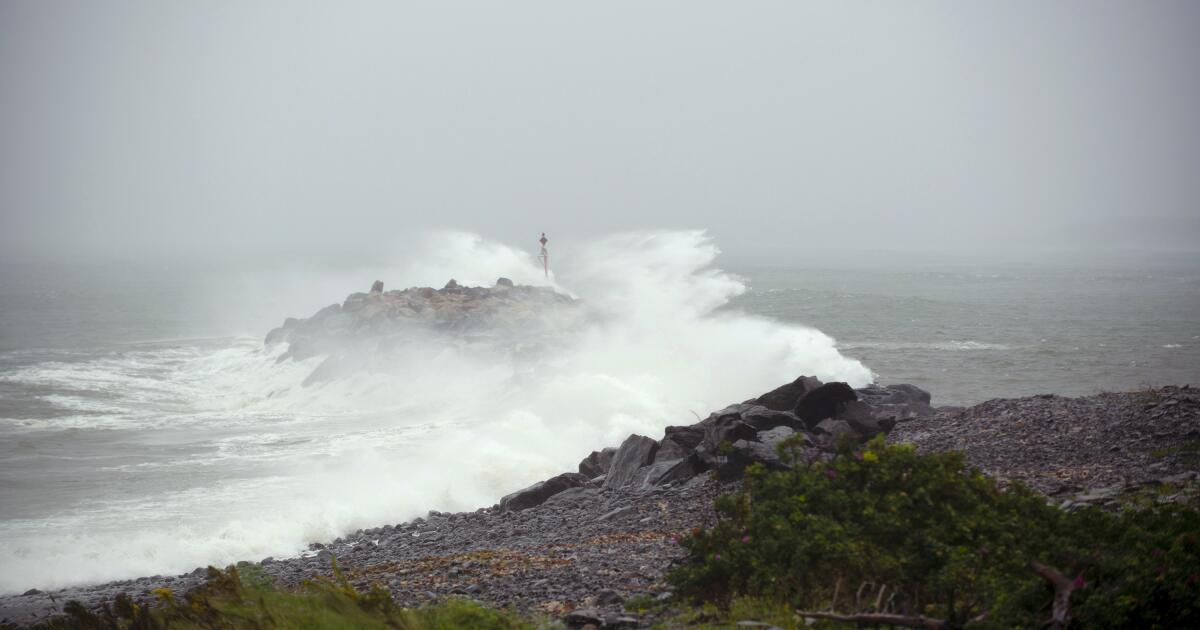Storm Lee battered a wide swath of New England and Atlantic Canada on Saturday, bringing destructive winds, high tides and torrential downpours that toppled trees, flooded roads and left tens of thousands of homes without power. A tree branch fell on a vehicle in Maine, killing one person.
The center of the massive tropical cyclone made landfall 215 kilometers (135 miles) west of Halifax, the capital of Nova Scotia, according to the US National Hurricane Center (NHC). The storm had sustained winds of 110 km/h (70 mph), although the storm weakened as it moved toward New Brunswick and the Gulf of St. Lawrence, they added.
In the United States, a tropical storm warning was in effect for 370 kilometers (230 mi) from Portsmouth, New Hampshire, to the eastern tip of Maine. That includes Bar Harbor, the tourist gateway to Acadia National Park, where a whale-watching boat broke off its dock and washed ashore in front of College of the Atlantic in Bar Harbor.
The Maine Department of Environmental Protection and the Coast Guard are working to prevent 1,800 gallons (6,800 liters) of diesel from washing up in the ocean, officials said.
Lee flooded coastal roads and boats in Nova Scotia, downed power lines and trees, and knocked ferries out of service, while spreading anxiety in a region still reeling from this summer’s wildfires and severe flooding. Halifax Stanfield International, Nova Scotia’s largest airport, has no flights scheduled to arrive or depart on Saturday.
“People are exhausted … so much in such a short period of time,” said Halifax councilor Pam Lovelace. “From a mental health perspective, we’re asking people to check on their neighbors.”
A tropical storm warning was in effect for parts of New Brunswick and Nova Scotia and Prince Edward Island, while a hurricane watch was in place for parts of New Brunswick and Nova Scotia.
Hurricane-force winds extended up to 140 miles (220 kilometers) from Lee’s center, and tropical storm-force winds had a range of up to 390 miles (630 kilometers), covering Maine and most of the state. Canada Sea.
The storm was so large that power was cut hundreds of kilometers from its center. As of Saturday afternoon, 11% of Maine customers were without power, followed by 27% in Nova Scotia, 8% in New Brunswick and 3% in Prince Edward Island.
A storm surge of 1 to 3 feet (30 to 90 centimeters) was predicted along the Maine coast, the NHC warned, and would be accompanied by large, destructive waves. The storm could drop up to 10 centimeters (4 inches) of rain in parts of Maine, Massachusetts, Nova Scotia and New Brunswick through Saturday night, forecasters said.
A 51-year-old motorist in Searsport, Maine, died after a large branch fell on his vehicle on U.S. Highway 1 Saturday, the first fatality attributed to the storm.
The branch brought down power lines, and workers had to shut off the power before extricating the man from his car, Police Chief Brian Lund said. The man later died in hospital. His identity has not been released.
The storm passed through some of the most waterlogged parts of Massachusetts, which experienced severe flooding days earlier, as fast-moving water washed away roads, inundated, damaged homes and flooded vehicles.
___
Sharp reports from Portland, Maine. Associated Press writers Robert Bumsted of Cape Elizabeth, Maine; Patrick Whittle in Portland, Maine; Michael Casey in Boston; Rob Gillies in Toronto and Cathy McCormack in Concord, New Hampshire contributed to this report.

“Music ninja. Analyst. Typical coffee lover. Travel evangelist. Proud explorer.”

:quality(85)/cloudfront-us-east-1.images.arcpublishing.com/infobae/TEQF6EONZRFGLLLDIDD4L2O4EE.jpg)

:quality(75)/cloudfront-us-east-1.images.arcpublishing.com/elcomercio/XU32LRAEZFDDPNVHLFU3CKVBYY.jpg)



More Stories
Earthquake in the US today, Wednesday, May 29 – Earthquake’s exact time, magnitude and location via USGS | USGS | composition
President Arrivalo is left with no alternatives to dismissing the Attorney General
Passenger dies after jumping off world’s largest cruise ship in Florida